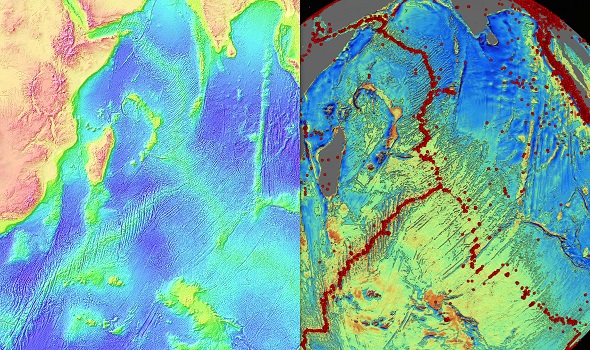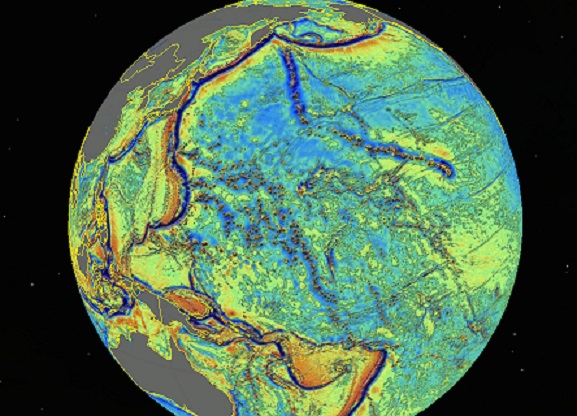The topography of Earth's seafloor is as corrugated and bumpy as a book set in Braille. By reading these peaks and ridges, scientists can chronicle the birth of new ocean crust and the past wanderings of Earth's continents.
However, even though the seafloor carries the pivotal clues to plate tectonics, the dry surface of Mars has been detailed more clearly than the ocean's watery depths.
The new map, released today (Oct. 2) in the journal Science, promises to fill in some of the blanks. Compared with the previous map, from 1997, the resolution is twice as accurate overall and four times as better in coastal areas and the Arctic, said lead study author David Sandwell, a marine geophysicist at the Scripps Institution of Oceanography in La Jolla, California.
Eyes in the sky
As with the earlier 1997 map, scientists expect to improve their knowledge of Earth's geologic history based on new features revealed by the map's finer scale.
"I think these data are pretty important in terms of the details that are going to come out," Sandwell told Live Science.
The seafloor topography comes from a gravity model of the ocean, which is in turn based on altimetry from the Jason-1 and Cryosat-2 satellites.
Altimetry measures sea surface height from space by timing how long it takes a radar signal to reflect off the ocean and return. The ocean surface has subtle highs and lows that mimic both seafloor topography and Earth's gravity field.
"[These] results are a breakthrough in space-based marine gravity observation," Cheinway Hwang, who was not involved in the study, wrote in a commentary accompanying the report. Hwang is a professor at National Chiao Tung University in Hsinchu, Taiwan.

The world's volcano count jumped tremendously thanks to the new map. The number of seamounts soared from around 5,000 to about 20,000, Sandwell said. Seamounts are small, conical volcanoes that are usually inactive or extinct. In the deep ocean, tall seamounts attract a riot of marine life. The map captures all seamounts more than 0.9 miles (1.5 kilometers) tall.
Some of the new seamounts appear in linear chains, but many do not. That suggests the volcanoes did not erupt above a mantle plume, a blob of hot rock that rises from the deep mantle (the layer under the crust). Some scientists think mantle plumes don't exist, but, as with climate change, the majority of researchers agree on the concept but argue about the details.
Finding patterns in the newly identified seamounts may help resolve the debate. "There's a notion that many linear volcanic chains aren't formed by mantle plumes, and I agree with that," Sandwell said. "If we can map out their complete distribution, then we can understand how they grow and evolve and so on."
The motion of Earth's tectonic plates created some of the most distinct features visible on the seafloor. These include spreading ridges and fracture zones, where the massive plates pull apart and lava oozes to the surface. Plates are created at spreading ridges and recycled at deep ocean trenches. The ocean trenches appear as deep blue troughs in the gravity map.
"Even now, I'm just amazed by how simple seafloor spreading patterns are," Sandwell told Live Science. "They're just like in the textbooks. It's just perfect plate tectonics."
Behold, Earth's wrinkles

Along coastlines, the data uncovered faults and fractures buried under thick piles of mud and sand pouring off the continents.
Sandwell and his colleagues highlighted the new details seen in fracture zones that extend from South America to Africa. "We can see these transform faults or fracture zones all the way up to the continental margins that are currently buried by sediments, and you couldn't before," Sandwell said. Though the two continents seem to fit together like puzzle pieces, "squiggles" in the fractures tell of tectonic complexity during their breakup, he added. "These are a new thing," Sandwell said. Analyzing such details around each continent will improve reconstructions of past plate motions.
In the Gulf of Mexico, the researchers identified a defunct spreading ridge now entombed under miles of sediment. The spreading ridge opened the gulf about 150 million years, when the Yucatan Peninsula pivoted counterclockwise from North America.
"Because of a major improvement in accuracy, this new gravity field will lead to more discoveries of tectonic features, especially in regions with thick sediments," Hwang wrote.
Most of the new ridges, faults and volcanoes were undiscovered because 80 percent of the ocean floor has never been charted by ships. The new topography will improve depth estimates in much of the ocean, the researchers said.




Reader Comments
Earth's gravitational profile is changing.
Mass is increasing and density decreasing.
The new mass is created in the core and finds its way up to the crust.
The human can join in the evolution or go extinct as 50% of all species.
[Link]
[Link]